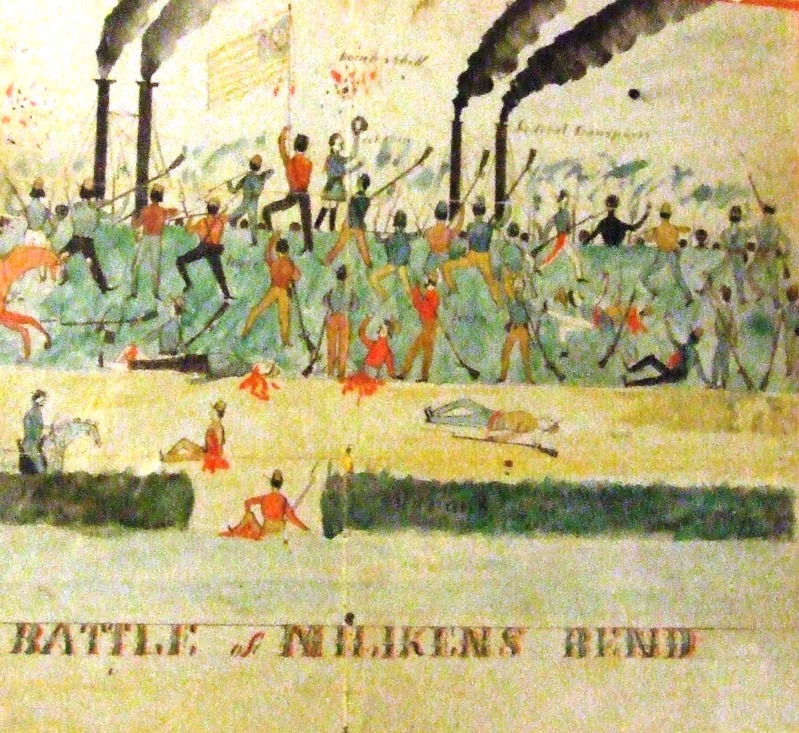Spectacular Eyewitness Image of Milliken’s Bend
One of the last acts of David Batey was to sketch this spectacular image of the fighting at Milliken’s Bend, and send it home to his family. Batey was a private in Company C, 17th Texas Infantry (Allan’s regiment) and just 18 years old. He was wounded in the leg, sent to Monroe Confederate Hospital, and according to family tradition, refused amputation. Instead of losing a leg, he lost his life. Infection set in. He died on June 28, 1863, and was buried in a mass grave near the hospital.
The first time I saw this image, I couldn’t believe my eyes! It was so well-rendered, complete with annotations. It is the only eyewitness image of the scene that I have ever encountered. It is even more significant because it portrays the fighting from the Confederate point of view. Confederate sources of any type for this battle are extremely scarce.
A close look at the image reveals some of the captions: At the top center is the word “bomb shell” accompanied by a bursting shell. To the right of that, the words “Federal transports” near the tall smokestacks. Beneath the “bomb shell” notation is another note, though indiscernible. It appears next to a Union officer in the center, raising his sword topped by his hat. The officer appears to be wounded in the shoulder.
Batey’s image is a stunning image of the battlefield landscape. He shows the fierce fighting on the levee, and the way in which the levee blocked the Confederate view. He has added the words “levee” in two locations, once between the two men in red shirts with bent black legs, one of them holding a captured U.S. flag; the second time, the word “levee” appears as a smudge just to the right of a red-shirted Reb loading his rifle beneath the right-hand Federal transport, at the base of the levee. The thick hedges, with a few gaps, are also shown in the foreground, with an indiscernible notation just to the right of the gap. One Rebel lies in the hedge-gap with a wounded leg. One wonders if this might be Batey’s self-portrait.
Batey shows the fierce nature of the fighting by showing blood spurting from many men, mostly Confederate wounded. It’s notable, too, to see how many men are fighting with clubbed muskets at the top of the levee, showing the desperate hand-to-hand fighting that took place there. Both sides were universally astonished at the savagery of the hand-to-hand combat, and how determined their enemy was to not give way. A closer look also shows Confederate troops shooting down on the Federals behind the levee – and a hint of how many Union men must have been there, by the dim outlines of bayonet tips just beyond the top of the levee, almost looking like thin tree branches.
The image that appears online seems like it might be a zoomed-in portion of a slightly larger work, but this online version is all that exists at this time. The original remains in private hands. The image posted above appears with permission, and fuller details about Batey, his experiences, and family, can be found at the McLemore Genealogy webpage.


Hello,
I had my son make as high a quailty print of the above and sent a copy to Ms. McLemore. She was and is a very gracious Texan. My ancestor John Hancock Smith, 5th Sergeant, 17th Texas Volunteers. Killed June 7, 1863 Milliken’s Bend.
My Great Grandfather, William M White, cpl, Company E of the 17th Texas Infantry fought at this battle and others. Was one of the companies captured at Fort DeRussy near Marksville, La.
My gggg grandfather was John Ayers, and was wounded at Milliken’s Bend LA, on June 7th while commanding a company of the 9th LA of African descent.
He later went on to be Commissioned as 1st Lieutenant of Company F of the Fifty Sixth Regiment Illinois Volunteer by IL Govenor Richard Yates.
“Gov. Yates, Sir, There being a call for more men I want to volunteer my service to the Government. I have been disabled at the top of my left arm and right four fingers and am not fit to go into the service, only as an officer. If you will give me a captain’s commissioning I will gladly except it , and recruit a company as soon as possible I send those references to assure you that I am in earnest.
yours obediently,
John W. Ayers,
Danvers M. Tenn”
The inscription on his gravestone reads, “1ST LT 56 ILL INF”
https://www.findagrave.com/memorial/38893652
Thank you for this story. I am always interested in hearing more about the experiences of the men who fought at Milliken’s Bend, and what happened to them afterward. Feel free to post more info if you’d like on the Descendant’s Page for the 9th Louisiana.